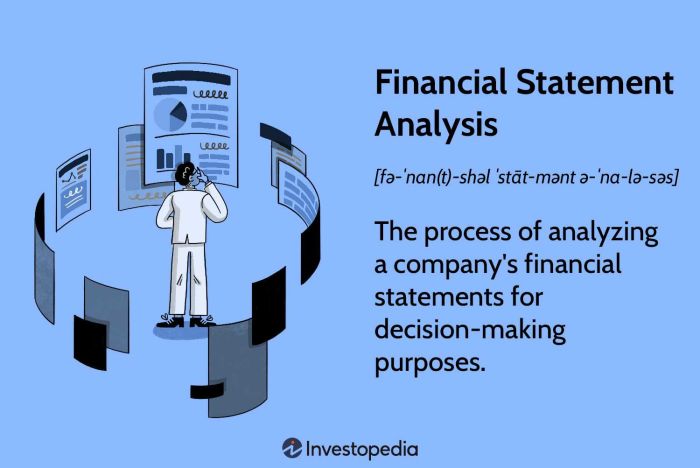Financial Statement Analysis Case Study
Financial statement analysis case: Dive headfirst into the thrilling world of deciphering corporate secrets! We’ll unravel the mysteries hidden within balance sheets, income statements, and cash flow statements – think of it as corporate archaeology, but with fewer dusty tombs and more exciting spreadsheets. Prepare for a journey into the heart of financial data, where numbers tell tales of triumph and tribulation, profit and peril. This isn’t your grandpappy’s accounting class; we’re talking real-world scenarios, nail-biting decisions, and the occasional accounting pun (because, why not?).
This exploration of financial statement analysis will equip you with the tools to dissect a company’s financial health. We’ll cover ratio analysis, trend analysis, forecasting, and benchmarking, all illustrated with hypothetical (but thrilling!) case studies. By the end, you’ll be able to spot a dodgy balance sheet a mile away and impress your friends (and possibly your boss) with your newfound financial acumen. Think of it as financial detective work, but instead of solving murders, you’re solving the mystery of a company’s profitability – equally exciting, we promise.
Introduction to Financial Statement Analysis Cases

Financial statement analysis in a case study setting isn’t just about crunching numbers; it’s about becoming a financial detective, uncovering the secrets hidden within a company’s financial reports. Think of it as a thrilling mystery novel, where the clues are scattered across balance sheets, income statements, and cash flow statements, and the solution – understanding the company’s financial health – is the ultimate reward. This analysis helps us understand a company’s performance, its financial strengths and weaknesses, and ultimately, predict its future prospects. It’s less accounting and more financial forensics.
Analyzing financial statements in a case study provides a practical application of theoretical knowledge. By dissecting real-world examples, we move beyond abstract concepts and gain a deeper understanding of how financial information impacts decision-making. This allows us to develop critical thinking and problem-solving skills applicable to various scenarios, from investment decisions to assessing creditworthiness.
Types of Financial Statements Used in Case Studies
Financial statement analysis relies heavily on three core documents: the balance sheet, the income statement, and the cash flow statement. These statements provide a comprehensive picture of a company’s financial position, performance, and cash flows, acting as a financial trinity revealing the company’s true nature. Think of them as three different lenses, each offering a unique perspective on the same subject.
The balance sheet, a snapshot in time, shows a company’s assets, liabilities, and equity at a specific point. It’s like a photograph capturing the company’s financial standing at that moment. The income statement, on the other hand, depicts a company’s revenues, expenses, and profits over a period. It’s like a movie showing the company’s financial performance over time. Finally, the cash flow statement tracks the movement of cash in and out of the company, offering insights into its liquidity and solvency. This statement reveals the reality behind the scenes – how much actual cash the company has and how it manages its resources.
Real-World Scenarios Requiring Financial Statement Analysis
Financial statement analysis is crucial in a multitude of real-world scenarios. Imagine you’re an investor considering buying stock in a tech startup. A thorough analysis of its financial statements would help you assess its profitability, growth potential, and overall financial health before committing your hard-earned money. Or, picture yourself as a lender evaluating a loan application from a small business. Analyzing its financial statements would be essential to determine its creditworthiness and the likelihood of repayment.
Another example could be a merger and acquisition situation. Companies meticulously analyze the target company’s financial statements to assess its value, identify potential risks, and ensure a successful integration. Furthermore, internal management uses financial statement analysis to monitor performance, identify areas for improvement, and make strategic decisions that drive profitability and growth. In essence, financial statement analysis is a vital tool for anyone making financial decisions, be it an investor, a lender, a manager, or even a curious consumer.
Ratio Analysis Techniques
Ratio analysis, the financial equivalent of a detective’s magnifying glass, allows us to peer into a company’s performance and uncover hidden truths. By skillfully manipulating a company’s financial statements, we can transform raw numbers into insightful narratives, revealing its strengths, weaknesses, and overall financial health. It’s a bit like alchemy, but instead of turning lead into gold, we turn balance sheets into actionable intelligence.
Profitability Ratios
Profitability ratios, as the name suggests, measure a company’s ability to generate profits. These ratios are essential for understanding how effectively a company manages its resources to create earnings. A high profitability ratio generally indicates a healthy and efficient business operation. Conversely, low ratios may signal potential problems. Let’s examine some key players.
| Ratio | Formula | Interpretation | Example |
|---|---|---|---|
| Gross Profit Margin | (Revenue – Cost of Goods Sold) / Revenue | Indicates the percentage of revenue remaining after deducting the direct costs of producing goods or services. A higher margin suggests efficient cost management. | A company with a gross profit margin of 40% retains 40 cents from every dollar of revenue after covering direct costs. |
| Net Profit Margin | Net Income / Revenue | Represents the percentage of revenue that translates into net income after all expenses, including taxes and interest, are deducted. A higher margin reflects greater profitability. | A net profit margin of 10% means the company earns 10 cents in profit for every dollar of revenue. |
| Return on Assets (ROA) | Net Income / Total Assets | Measures how effectively a company uses its assets to generate earnings. A higher ROA indicates better asset utilization. | An ROA of 5% means the company generates $5 in profit for every $100 of assets. |
| Return on Equity (ROE) | Net Income / Shareholder’s Equity | Shows how effectively a company uses shareholder investments to generate profits. A higher ROE indicates a better return for investors. | An ROE of 15% means the company generates $15 in profit for every $100 of shareholder equity. |
Liquidity Ratios
Liquidity ratios are like a company’s financial pulse; they reveal its ability to meet its short-term obligations. These ratios are crucial for assessing a company’s immediate solvency. A healthy liquidity position is essential for smooth operations and prevents financial distress. Let’s compare some common measures.
| Ratio | Formula | Interpretation | Application in Case Studies |
|---|---|---|---|
| Current Ratio | Current Assets / Current Liabilities | Measures the ability to pay off short-term liabilities with current assets. A ratio above 1 generally indicates sufficient liquidity. | Analyzing a company’s ability to meet its immediate debt obligations, particularly during economic downturns. |
| Quick Ratio | (Current Assets – Inventory) / Current Liabilities | A more conservative measure than the current ratio, as it excludes inventory (which may not be easily liquidated). | Assessing the liquidity of companies with high inventory levels or those in industries with volatile inventory values. |
| Cash Ratio | (Cash + Cash Equivalents) / Current Liabilities | The most stringent liquidity measure, focusing only on readily available cash. | Evaluating the immediate short-term solvency of a company facing a cash crunch or experiencing unexpected financial difficulties. |
Solvency Ratios
Solvency ratios, unlike their liquidity counterparts, provide a longer-term perspective, evaluating a company’s ability to meet its long-term obligations. These ratios help assess the overall financial risk associated with a company. High levels of debt can significantly impact a company’s financial stability.
Debt-to-Equity Ratio = Total Debt / Shareholder’s Equity
This ratio shows the proportion of a company’s financing that comes from debt versus equity. A higher ratio indicates greater financial risk, as a heavily indebted company is more vulnerable to economic downturns. For instance, a company with a debt-to-equity ratio of 2.0 relies twice as much on debt financing as equity. This makes it more sensitive to interest rate changes and economic fluctuations.
Times Interest Earned = Earnings Before Interest and Taxes (EBIT) / Interest Expense
This ratio indicates a company’s ability to meet its interest obligations. A higher ratio signifies lower financial risk. For example, a times interest earned ratio of 5 suggests that the company’s earnings are five times its interest expense, providing a significant buffer against potential interest payment difficulties. Conversely, a ratio below 1 suggests the company may struggle to cover its interest payments. This could signal potential financial distress.
Trend Analysis and Forecasting
Predicting the future is a tricky business, even for seasoned financial analysts. While we can’t predict the next lottery winner (sadly!), we *can* use historical data to get a pretty good sense of where a company might be headed. This is where trend analysis and forecasting come in – think of it as financial crystal ball gazing, but with spreadsheets instead of mystical orbs.
Trend analysis is all about identifying patterns in financial data over time. We’re looking for those consistent upward or downward movements that tell a story about a company’s performance. Forecasting, on the other hand, takes those trends and projects them into the future, allowing us to make educated guesses (not wild speculations!) about future financial performance. It’s like drawing a line from the past and extending it into the future, hoping it doesn’t suddenly take a sharp turn into a ditch.
Line Graph Representation of Revenue Growth
Imagine a line graph charting the revenue of “Acme Explosives,” a fictional (and hopefully, safe) company. The x-axis represents the years (2019-2023), and the y-axis represents revenue in millions of dollars. In 2019, Acme’s revenue was a modest $10 million. By 2020, it jumped to $15 million, showcasing a healthy growth spurt. 2021 saw a slight dip to $14 million, perhaps due to a temporary market downturn or a particularly explosive incident (pun intended!). However, Acme bounced back strongly in 2022, reaching $20 million, demonstrating resilience. Finally, in 2023, revenue climbed to a record-breaking $25 million. The line on the graph would show a generally upward trend, with a minor blip in 2021, demonstrating overall growth. This visual representation makes it easy to spot the trend and understand the company’s financial health.
Forecasting Future Financial Performance
Forecasting involves a bit more detective work than simply drawing a line. Here’s a step-by-step guide, complete with a healthy dose of caution:
A successful forecast relies on a methodical approach. It’s not about throwing darts at a board and hoping for the best.
- Gather Historical Data: Collect relevant financial data, such as revenue, expenses, and profits, over a sufficient period. The longer the period, the more reliable the trend identification. Think years, not weeks.
- Analyze Historical Trends: Identify patterns and trends in the data. Are sales consistently increasing? Are costs rising faster than revenue? Are profits stable or fluctuating wildly? Look for those clues that whisper secrets about the future.
- Consider Industry Trends: Research industry-wide trends and economic factors that could impact the company’s future performance. Is the industry booming or facing headwinds? Understanding the broader context is crucial.
- Develop a Forecasting Model: Choose a forecasting method, such as simple linear regression or more sophisticated time series analysis. The complexity of the model should match the complexity of the data and the level of accuracy required.
- Generate Forecasts: Use the chosen model to project future financial performance based on historical data and identified trends. Remember, these are educated guesses, not guarantees. Expect some level of uncertainty.
- Evaluate and Refine: Regularly review and refine the forecast as new data becomes available. The world changes, and so should your forecasts.
Limitations of Trend Analysis and External Factors
While trend analysis and forecasting are powerful tools, they’re not foolproof. They’re only as good as the data they’re based on, and they don’t account for unforeseen events. A sudden economic downturn, a disruptive technological innovation, or a global pandemic (let’s not dwell on that one) can throw even the best-laid plans into disarray. Therefore, it’s crucial to consider external factors and to acknowledge the inherent uncertainty in any forecast. Think of it as a helpful guide, not a divine prophecy. Always remember that unexpected events can and will occur, throwing the best-laid plans into disarray. Flexibility and adaptability are key.
Comparative Analysis: Financial Statement Analysis Case

Financial statement analysis isn’t just about staring at numbers until your eyes glaze over; it’s about understanding the narrative those numbers tell. And one of the most compelling chapters in that narrative is comparative analysis – pitting your chosen company against its rivals in a thrilling battle of balance sheets and income statements. Think of it as the financial equivalent of a cage match, but instead of bruised egos, we have insights into market positioning and potential pitfalls.
Comparative analysis, or benchmarking, involves comparing a company’s financial performance against its industry peers. This allows us to assess its relative strengths and weaknesses, identify areas for improvement, and gain a better understanding of its competitive position. It’s like comparing your grades to those of your classmates – except instead of just bragging rights, you get valuable business intelligence.
Benchmarking Key Financial Ratios
To illustrate, let’s consider three hypothetical companies in the fast-food industry: Burger Bliss, Patty Paradise, and Fries Frenzy. The following table compares their key financial ratios for the most recent fiscal year. Remember, these are hypothetical examples, and real-world data would be significantly more complex and nuanced.
| Ratio | Burger Bliss | Patty Paradise | Fries Frenzy |
|---|---|---|---|
| Profit Margin | 10% | 12% | 8% |
| Return on Assets (ROA) | 5% | 7% | 4% |
| Debt-to-Equity Ratio | 0.5 | 0.8 | 0.3 |
| Current Ratio | 1.8 | 1.5 | 2.2 |
Identifying Strengths and Weaknesses through Comparison
Analyzing the table reveals some interesting insights. Patty Paradise boasts the highest profit margin and ROA, suggesting superior operational efficiency and profitability compared to its competitors. However, its higher debt-to-equity ratio indicates a greater reliance on debt financing, which could pose risks in times of economic downturn. Conversely, Fries Frenzy shows a strong current ratio, indicating excellent short-term liquidity, but lags behind in profitability. Burger Bliss sits somewhere in the middle, exhibiting a balanced profile but without any standout performance. This comparative analysis highlights the need for a holistic view, considering multiple ratios rather than focusing solely on one metric.
Industry-Specific Factors in Comparative Analysis
It’s crucial to remember that comparing companies across industries is like comparing apples and oranges – it simply doesn’t work. Industry-specific factors significantly influence financial ratios. For example, a high debt-to-equity ratio might be perfectly acceptable in a capital-intensive industry like manufacturing but raise concerns in a less asset-heavy industry like software development. Therefore, benchmarking should always be conducted within the same industry to ensure a meaningful comparison. Failing to account for these industry nuances can lead to inaccurate conclusions and flawed strategic decisions. Consider the regulatory landscape, competitive pressures, and even consumer preferences when interpreting these ratios – the context is king!
Case Study Application

Let’s dive headfirst into the wonderfully chaotic world of financial statement analysis with a real-life (well, hypothetically real-life) case study. Buckle up, because this is where the rubber meets the road – or, more accurately, the rubber meets the increasingly precarious balance sheet of “Floppy Disks R’ Us,” a company clinging desperately to the past.
Floppy Disks R’ Us: A Case of Terminal Nostalgia
Floppy Disks R’ Us, once a titan of the data storage industry (yes, really), is now facing a rather… floppy future. Their recent financial statements paint a rather grim picture, a masterpiece of fiscal mismanagement if you will. Let’s examine the numbers, shall we?
| Floppy Disks R’ Us – Income Statement (in thousands) | 2022 | 2023 |
|---|---|---|
| Revenue | 500 | 300 |
| Cost of Goods Sold | 300 | 200 |
| Gross Profit | 200 | 100 |
| Operating Expenses | 150 | 120 |
| Operating Income | 50 | (20) |
| Interest Expense | 10 | 15 |
| Net Income | 40 | (35) |
| Floppy Disks R’ Us – Balance Sheet (in thousands) | 2022 | 2023 |
|---|---|---|
| Assets | ||
| Cash | 20 | 5 |
| Inventory | 100 | 150 |
| Total Assets | 120 | 155 |
| Liabilities & Equity | ||
| Accounts Payable | 30 | 40 |
| Long-Term Debt | 50 | 70 |
| Equity | 40 | 45 |
| Total Liabilities & Equity | 120 | 155 |
Key Financial Issues
The financial statements reveal a company hemorrhaging money. Revenue is plummeting, leading to a significant drop in profitability. The increase in inventory suggests an inability to sell their outdated products. Simultaneously, debt is rising, putting further pressure on the company’s already strained finances. The negative net income in 2023 is a particularly alarming sign.
Potential Solutions
The following strategies could help Floppy Disks R’ Us avoid a complete data meltdown:
- Embrace the Cloud (or at least, something more modern): Diversify into more relevant products and services. The world has moved on from 5.25-inch floppies. Perhaps cloud storage solutions or USB drives might be a more lucrative path.
- Inventory Management Overhaul: Implement a rigorous inventory management system to reduce excess stock and associated carrying costs. This might involve aggressive discounting to clear out obsolete inventory. Think “going-out-of-business” sale, but hopefully not literally.
- Debt Restructuring: Negotiate with creditors to restructure existing debt, potentially extending repayment terms or lowering interest rates. This will provide some breathing room and improve cash flow.
- Cost Cutting Measures: Identify and eliminate unnecessary operating expenses. This could involve streamlining operations, negotiating better deals with suppliers, or even reducing staff (a painful but potentially necessary step).
- Seek External Funding: Explore options for securing additional funding through loans, equity financing, or even crowdfunding (though that might be ironically fitting given their name). This injection of capital could help them weather the storm.
Common Pitfalls in Financial Statement Analysis

Financial statement analysis, while a powerful tool for understanding a company’s financial health, is fraught with potential pitfalls. Like a delicious but deceptively spicy curry, it can leave the unwary analyst with a burning sensation (of regret, that is). Understanding these common errors is crucial to avoid drawing inaccurate conclusions and making poor investment decisions. Ignoring these pitfalls can lead to results as reliable as a fortune cookie’s prediction of your future wealth.
Interpreting financial ratios and trends requires more than just number crunching; it demands a keen eye for detail and a healthy dose of skepticism. A single misleading figure can send your analysis spiraling into a vortex of incorrect assumptions. This section will highlight some common errors and explain how to avoid them, transforming you from a financial statement novice into a seasoned, ratio-wielding expert.
Errors in Interpreting Financial Ratios and Trends
The calculation of financial ratios is only half the battle. Misinterpreting the results is a common error. For example, a high debt-to-equity ratio might indicate excessive risk, but it could also reflect a company’s aggressive but successful expansion strategy, funded by readily available and low-cost debt. Similarly, a declining profit margin might be due to increased competition, or it could signal internal inefficiencies requiring immediate attention. Context is king! Failure to consider the broader economic environment, industry trends, and the specific circumstances of the company can lead to misleading interpretations. Analyzing ratios in isolation, without considering other relevant factors, is like trying to understand a novel by reading only a single sentence—you miss the whole story. A holistic approach, considering the interplay between different ratios and external factors, is essential for a comprehensive analysis.
Impact of Accounting Methods and Estimations
Accounting standards offer flexibility, which, while necessary, can create inconsistencies between companies’ financial statements. Different accounting methods for depreciation, inventory valuation, or revenue recognition can significantly impact reported financial figures. For instance, using the accelerated depreciation method will show lower profits in the early years of an asset’s life compared to the straight-line method. This difference can dramatically alter the trend of profitability over time. Furthermore, estimations inherent in accounting, such as the allowance for doubtful accounts or the useful life of assets, introduce subjectivity and potential bias. A company’s choice of accounting policies can be strategically influenced, further complicating the analyst’s task. Therefore, it is crucial to understand the accounting methods employed by a company and to compare companies using consistent methodologies whenever possible. Failing to account for these variations can lead to inaccurate comparisons and flawed conclusions. For example, comparing a company using FIFO (First-In, First-Out) inventory valuation to one using LIFO (Last-In, First-Out) during inflationary periods could lead to dramatically different cost of goods sold and net income figures, making direct comparison problematic.
Importance of Qualitative Factors in Assessing Financial Health, Financial statement analysis case
Financial statements present a quantitative picture, but a company’s financial health is also significantly influenced by qualitative factors. These non-numerical aspects, often overlooked, can be just as critical as the numbers themselves. Consider a company with strong financial ratios but facing significant legal challenges or experiencing reputational damage due to a major product recall. The quantitative data might look impressive, but the qualitative factors paint a far less optimistic picture. Other crucial qualitative factors include management quality, employee morale, competitive landscape, technological advancements within the industry, and the overall economic climate. Ignoring these qualitative factors leads to an incomplete and potentially misleading assessment. A thorough financial statement analysis must integrate both quantitative and qualitative information to gain a truly comprehensive understanding of a company’s prospects. For example, a company with consistently high profitability but a history of aggressive accounting practices and questionable management decisions might appear financially sound on paper but poses a significant investment risk.
Wrap-Up

So, there you have it – a whirlwind tour through the fascinating world of financial statement analysis. We’ve journeyed from the basics of ratio analysis to the art of forecasting, all while dodging the pitfalls of misinterpretation and questionable accounting practices. Remember, numbers don’t lie, but they can certainly be misleading if not properly understood. Armed with the knowledge gained here, you can confidently navigate the complex landscape of corporate finance, armed with more than just a calculator; you have insight. Go forth and analyze!
Quick FAQs
What’s the difference between liquidity and solvency ratios?
Liquidity ratios (like current and quick ratios) measure a company’s ability to meet its short-term obligations, while solvency ratios (like debt-to-equity) assess its ability to meet its long-term obligations and overall financial stability. Think of it as the difference between paying your rent this month (liquidity) versus paying off your mortgage (solvency).
Why is qualitative analysis important?
While numbers are crucial, qualitative factors (management quality, industry trends, competitive landscape) provide context and can significantly impact a company’s financial health. Numbers tell part of the story; qualitative factors reveal the narrative behind the figures.
How can I improve my financial statement analysis skills?
Practice, practice, practice! Analyze real-world company statements, participate in case competitions, and seek out additional resources like textbooks and online courses. The more you practice, the sharper your analytical skills will become. Think of it as a financial martial art; the more you train, the more proficient you’ll be.



